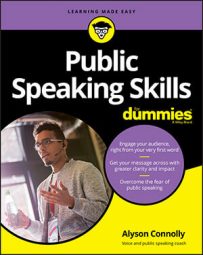If you’re a natural devoicer
Devoicing, as I’ve mentioned, is a legitimate way to speak to someone in certain situations. Maybe you do it a lot. But it’s almost impossible to be heard when you devoice to a large crowd — in that situation, your voice must have the timbre to sustain a strong message.
Maybe you find it hard to draw attention to yourself. You can’t make yourself heard in social scenes. Maybe you’re constantly asked to repeat yourself. That gets tiresome. Devoicers can become so hard to communicate with the listener just stops trying. That can damage confidence. So how do you speak sentimentally when you have to use a full voice?One way I’ve taught my clients to overcome this is to do away with the idea that emotions have their own volume. Of course, there may be times in a speech where you get louder. But the point is to never dip too low, regardless of whether is time to be sentimental or not.
Not all devoicing comes from emotion. Where you look with your eyes and body position can cause it, too. Something I see quite a bit is speakers applying one of the most harmful body positions you’ll ever see onstage: the down and in position. This looks exactly the way you picture it: looking down, arms scrunched together, trying their darnedest to sink into those floorboards. And where are they looking? Directly in front of their feet. Not good. Speak to an audience the way you speak to someone — you look at them, or close to them.Your body position follows your eyes.
Body position is a tricky thing to have to figure out onstage. Sometimes when you’re onstage, you can’t see anyone anyway, so what are you supposed to look at? If you’re around a boardroom table, are you looking at everyone directly in the face? For many, it’s easier to sink into themselves and stare at the floor than to stare the boss in the eyes as if over tiramisu on a fantastic date.Here’s a simple solution: Look the audience in the eye. Yup, I mean it. You know the saying “the eyes are the windows to the soul”? Well, they are in Chris Anderson’s book Ted Talks (HarperCollins, 2016). He writes that the best speakers look at the audience: “Great speakers find a way of making an early connection with their audience. It can be as simple as walking confidently onstage, looking around, making eye contact with two or three people, and smiling.” When you look at someone in the audience, you form a connection with that person, if only for a few seconds. It builds trust in you and makes the audience member feel important. It makes you feel more confident and powerful. If you don’t look people in the eye, that gives them the opportunity to look away from you and focus on something else. So, find someone in the audience and look at that person for no more than 5–6 seconds, then move on. You could even add a smile; why not? You will transfer the same feeling to the other person. It’s a win-win.
Exercise: Command the Crowd
You’ve gotten rid of devoicing, you’ve found your breath, and you know where to look. It’s time to command the crowd. How do you do that? With passion, of course. Use your emotional connection to your speech. When you’re invested in speaking because it’s important to you, you get inspired, and you then transfer that energy to your voice.It’s time to chant. Oh, what’s that? I’ve gone off the deep end? Bear with me, folks.
Take a piece of text. Any piece of text. It could be the warning on a coffee cup stating that it’s hot, or the label on your favorite beer. If you’re feeling frisky, it could be a sentence you’ve written in your speech. Now take video or record yourself speaking the text the way you think you’d say it during your presentation. Pick a pitch that is comfortable for you, right in the middle of your range. Take a breath as if from deep in your abdomen and then let go. Chant the sentence. For example: “Thank you for coming.” Then immediately speak the same sentence, quickly enough that you don’t have time to analyze your voice. On the video or recording, take a look at both versions. What’s different about the second? It should sounds more natural than the first.

